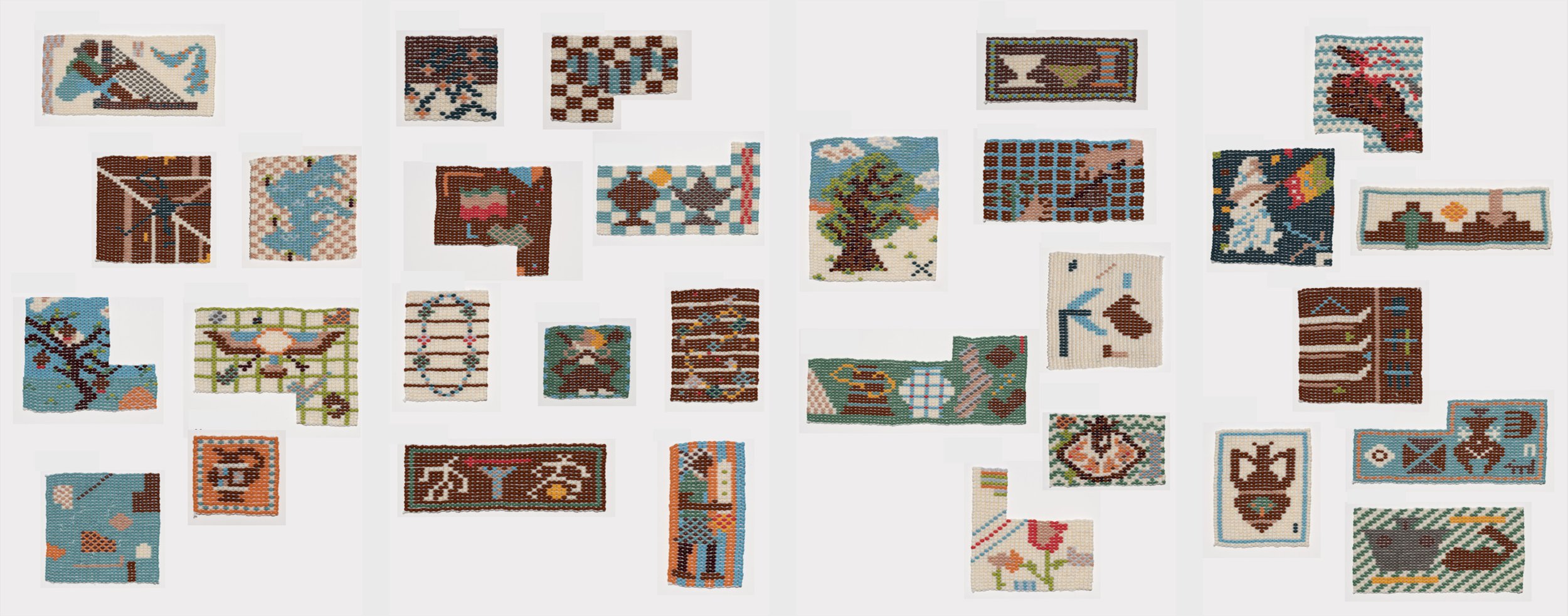'Thieves' Market' by Areez Katki
/Areez Katki Thieves’ Market (2018–2021), thirty individual tapestry fragments, Czech glass beads and mercerised cotton thread, 300 × 1740mm / Courtesy of Areez Katki and TARQ
Areez Katki works with a range of materials like paper and clay but textiles have largely been his focus over the last decade or so. He gathers and repurposes old, found, and sometimes remnants of newer textiles that have a familial and deeply personal connection, or more political and historical threads. Areez engages with ancient indigenous histories, including his own Zoroastrian heritage. Some of his work cites artefacts, architectural motifs and subjects from a destroyed and pilfered past.
We have been following Areez's work for a while through one of our clients, TARQ, that represents him in India. A very special piece from his recent body of work is Thieves' Market, a tapestry made up of several fragments that reference lost, excavated, and even stolen, objects and artefacts that are now mostly housed in glass cases in European museums, such as the Louvre and the British Museum. Each fragment is handwoven in the traditional Zoroastrian toran beadwork technique using Czech glass beads that the artist inherited from his maternal great-grandmother. We got a chance to see the work up close at TARQ’s booth at the India Art Fair 2024 and were fascinated by the details on each fragment, a selection of which we are highlighting below.
“By dwelling on his experience of exile and the loss of connection to one’s ancestral land, Katki seeks to expand the archive of anxieties inherited from his migrant parents. As a queer Parsi who migrated from Mumbai to Aotearoa (New Zealand) at an early age, Katki is deeply aware of the labour of integration that a migrant is expected to perform to fit in better.”
Fragment 1: Female harpist from a Sassanid floor mosaic extracted from the Iwan of Shapur I, c. 260 CE, Bishapur, present-day Iran. Collection: Musée du Louvre, Paris
Fragment 3: Punica granatum — pomegranate tree. Both its leaves and fruit are an important Zoroastrian sacrament
Fragment 5: Faravahar — a winged Zoroastrian symbol representing the personal spirit
Fragment 11: An abstraction based on the ‘Valley of Knowledge’ from Farid ud-Din Attar’s The Conference of the Birds
Fragment 12: Achaemenid necklace (reconstructed) of gold and various precious stones ‘found’ at the Acropolis of Susa, sixth century BCE, present-day Iran. Collection: Musée du Louvre
dETAIL OF Thieves’ Market (2018–2021), thirty individual tapestry fragments, Czech glass beads and mercerised cotton thread, 300 × 1740mm
“Firstly, craft is such a charged word; one which I think needs to be inspected more thoughtfully. I think that anything done well, with integrity and rigorous commitment, should be deemed craft —and that includes any form of creative expression, which does not exclude contemporary art mediums that fall into the ‘higher art’ hegemony. ”
“I feel this hierarchy eerily incongruous at times, especially when craft or material-based work is segregated. My engagement with craft and its histories via ancient trade routes and transcultural exchanges of knowledge are done with the intent to demonstrate work in physical form that perhaps cannot be illustrated in any other medium.”
Fragment 13: Fish-tailed deity holding snakes, from a sandstone bas-relief of Elamite King Untash-Napirisha ‘found’ at Tchogha Zanbil, c. 1340–1300 BCE, Susa, present-day Iran. Collection: Musée du Louvre
Fragment 14: Parsi schoolboys playing soccer at Sir Ratan Tata Parsi Colony, Mumbai
“I suppose that, much like anyone in my position, the underlying intentions behind my material-focused projects come from a sense of curiosity and fascination with the surfaces of mediums that I have committed to engaging with: textiles and writing.”
“My time in Iran and India proved incredibly nourishing for those aforementioned reasons: the ability to tap into memory and information that I did not otherwise have. The work then forms visceral and instinctual responses to cities around Parsi spaces, particularly in South Mumbai.”
Fragment 17: Cupressus sempervirens — Sarv- e-Abarkooh, a cypress tree more than 4,000 years old and one of the oldest living organisms in the world, is sacred to Zoroastrians. Today its Indigenous spiritual associations have been widely supressed and replaced with Abrahamic mythology. Yazd Province, present-day Iran
Fragment 23: An abstraction based on the ‘Valley of Wonderment’ from Farid ud-Din Attar’s The Conference of the Birds
Fragment 25: Representation of Madam Bhikaiji Cama (1861–1936), a Parsi-born freedom fighter who designed and embroidered the first prototype of India’s tricolour flag (known today as the ‘Calcutta Flag’), and hoisted it at the Stuttgart International Socialist Conference in 1907 as an act of defiance against the British colonial occupation of India. Cama was then exiled from India, or any crown soil, and died eleven years before India’s independence in 1947
Fragment 29: A deconstruction of the decorative elements painted on a (fired and glazed) Elamite clay bowl, sixth century BCE, excavated from Haft Tappeh, Susa, present-day Iran. Collection: Musée du Louvre
Visit the TARQ website to explore more works by Areez Katki, including from his second solo exhibition at the gallery, As this chin melts on your knee.













